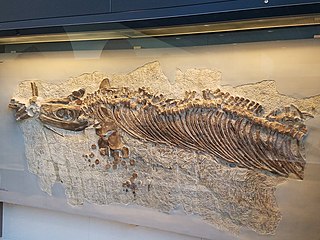
Cymbospondylus is an extinct genus of large ichthyosaurs, of which he is among the oldest representatives, that lived during the Anisian stage of the Middle Triassic in what are now North America and Europe. The first known fossils of this taxon are a set of more or less complete vertebrae which were discovered in the 19th century in various mountain ranges of Nevada, in the United States, before being named and described by Joseph Leidy in 1868. It is in the beginning of the 20th century that more complete fossils were discovered through several expeditions launched by the University of California, and described in more detail by John Campbell Merriam in 1908, thus visualizing the overall anatomy of the animal. While many species have been assigned to the genus, only five are recognized as valid, the others being considered synonymous, doubtful or belonging to other genera. Cymbospondylus was formerly classified as a representative of the Shastasauridae, but more recent studies consider it to be more basal, view as the type genus of the Cymbospondylidae.
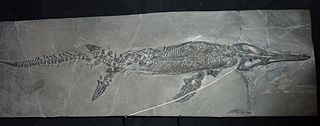
Mixosaurus is an extinct genus of Middle Triassic ichthyosaur. Its fossils have been found near the Italy–Switzerland border and in South China.
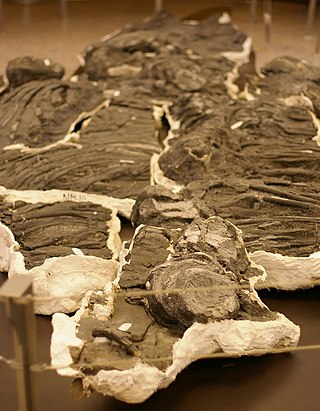
Shastasauridae is an extinct family of Triassic ichthyosaurs. The family contains the largest known species of ichthyosaurs, which include some of and possibly the largest known marine reptiles.

Shastasaurus is an extinct genus of ichthyosaur from the Late Triassic. Specimens have been found in the United States, Canada, and China.
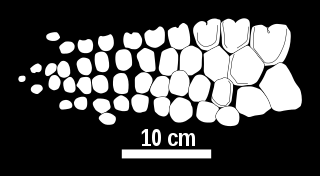
Chacaicosaurus is a genus of neoichthyosaurian ichthyosaur known from the Middle Jurassic of Argentina. The single known specimen of this genus was excavated from the Los Molles Formation in Neuquén Province, and is housed at the Museo Olsacher under the specimen number MOZ 5803. This specimen consists of a skull, forelimb, some vertebrae, and some additional postcranial elements. The genus was named by Marta Fernández in 1994, and contains a single species, Chacaicosaurus cayi, making it the first named distinctive ichthyosaur from the Bajocian stage. It is a medium-sized ichthyosaur with a very long snout, which bears a ridge running along each side. The forelimbs of Chacaicosaurus are small and contain four main digits.

Besanosaurus is a genus of Middle Triassic ichthyosaur from Monte San Giorgio of Italy and Switzerland, containing the single species B. leptorhynchus. Besanosaurus was named by Cristiano Dal Sasso and Giovanni Pinna in 1996, based on the nearly complete flattened skeleton BES SC 999, the holotype specimen. This skeleton is preserved across multiple thin rock slabs spanning 3.5 by 4 metres when assembled and took thousands of hours to prepare. Additional specimens from Monte San Giorgio that have previously been considered separate genera, including a partial skull named Mikadocephalus and a well-preserved, largely complete skeleton, have been reinterpreted as additional specimens of Besanosaurus.
Callawayia is an extinct genus of ichthyosaur. It contains the species Callawayia neoscapularis.
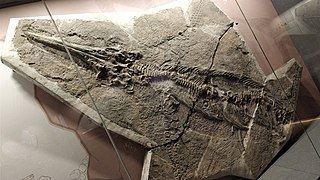
Guizhouichthyosaurus is an extinct genus of ichthyosaur which is known primarily from the Xiaowa Formation of the lower Carnian stage of the Late Triassic in southwest China. The type species of this genus is Guizhouichthyosaurus tangae, of which multiple skeletons are known. It has been reassigned as a species of the genus Shastasaurus in the past, though it has since been considered distinct. The ichthyosaurs Cymbospondylus asiaticus, named in 2002, and Panjiangsaurus epicharis, named in 2003, are junior synonyms of G. tangae. The genus is also known from the Ladinian-aged Middle Triassic Zhuganpo Formation; additionally, the species "Callawayia" wollongangense may belong to Guizhouichthyosaurus.

Mikadocephalus is an extinct genus of ichthyosaur. Its remains have been found in Europe, in the Anisian of Switzerland. The type species is Mikadocephalus gracilirostris. In 2021, Bindellini and colleagues considered M. gracilirostris to be a junior synonym of Besanosaurus leptorhynchus.

Phalarodon is an extinct genus of mixosaurid ichthyosaur known from the Middle Triassic. Its name is derived from the Greek φάλαρα (phálara) and odon ("tooth"). The genus has had a tumultuous history since its classification in 1910, with different workers describing species under different genera or declaring the genus to be a nomen dubium. Currently three species are recognized, but more have been identified in the past.

Qianichthyosaurus is an extinct genus of ichthyosaur from the Ladinian and Carnian stages of the Late Triassic epoch. Its fossils have been found in southeastern China, in Carnian rocks of the Falang Formation near Huangtutang, Guizhou. The type species is Qianichthyosaurus zhoui, named by Chun Li in 1999. A second species, Qianichthyosaurus xingyiensis, was named from older (Ladinian) deposits in the Falang Formation in 2013 by Pengfei Yang and colleagues. Complete Qianichthyosaurus fossils are common in the Xiaowa Formation, with both juveniles and pregnant specimens being known; its larger contemporaries, Guizhouichthyosaurus and Guanlingsaurus, are rarer.
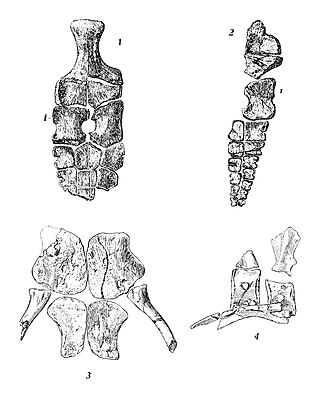
Toretocnemus is an extinct genus of ichthyosaur. Its remains have been found in California, United States, in Triassic layers of the Carnian Hosselkus Limestone.
Wimanius is a genus of ichthyosaur from the Middle Triassic of Switzerland, containing a single species, Wimanius odontopalatus. It was described by Michael Maisch and Andreas Matzke in 1998 based on an incomplete skull from Monte San Giorgio, a mountain on the Swiss-Italian border. Wimanius possesses teeth on its palate, though whether they were located on the palatine or pterygoid is disputed. Other features of Wimanius include a large orbit and jugals with two rami of similar lengths. Different phylogenetic placements of Wimanius have been recovered by different studies, including it being a mixosaurid relative or a merriamosaur, and a monotypic family, Wimaniidae has been named for it. However, its validity has also been questioned, and synonymy with various other genera has been proposed. The only specimen of Wimanius come from the Besano Formation. During the Anisian, this region was a lagoon populated by a wide variety of marine life, including a variety of other ichthyosaurs.
Mixosauridae was an early group of ichthyosaurs, living between 247.2 and 235 million years ago, during the Triassic period. Fossils of mixosaurs have been found all over the world: China, Timor, Indonesia, Italy, Germany, Spitsbergen, Switzerland, Svalbard, Canada, Alaska, and Nevada.

Parvipelvia is an extinct clade of euichthyosaur ichthyosaurs that existed from the Late Triassic to the early Late Cretaceous of Asia, Australia, Europe, North America and South America. Named by Ryosuke Motani, in 1999, it contains the basal taxa like Macgowania and Hudsonelpidia. Maisch and Matzke (2000) found in their analysis seven synapomorphies that support Parvipelvia. They also found 10 synapomorphies that support the existence of post-Triassic clade of ichthyosaurs, for which the name Neoichthyosauria was found to be available. Parvipelvians were the only ichthyosaurs to survive the Triassic-Jurassic extinction event.

The Hueneosauria are a group of Ichthyosauria, living during the Mesozoic.

Thalattoarchon is a genus of large, Middle Triassic predatory ichthyosaur from North America, containing the single species T. saurophagis. The taxon was described in 2013 from a single specimen discovered in the Favret Formation in Nevada. The generic name, meaning "ruler of the seas", refers to its status as an apex predator, while the specific epithet, meaning "lizard eater", alludes to its carnivorous diet. The classification of this genus within the ichthyosaurs is much debated, being either classified within the clade Merriamosauria or in the more basal family Cymbospondylidae.

This timeline of ichthyosaur research is a chronological listing of events in the history of paleontology focused on the ichthyosauromorphs, a group of secondarily aquatic marine reptiles whose later members superficially resembled dolphins, sharks, or swordfish. Scientists have documented ichthyosaur fossils at least as far back as the late 17th century. At that time, a scholar named Edward Lhuyd published a book on British fossils that misattributed some ichthyosaur vertebrae to actual fishes; their true nature was not recognized until the 19th century. In 1811, a boy named Joseph Anning discovered the first ichthyosaur fossils that would come to be scientifically recognized as such. His sister Mary would later find the rest of its skeleton and would go on to become a respected fossil collector and paleontologist in her own right.























